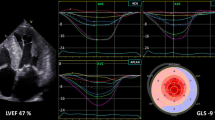Abstract
The clinical presentation of idiopathic dilated cardiomyopathy (IDCM) heart failure (HF) patients who will respond to medical therapy (responders) and those who will not (non-responders) is often similar. A machine learning (ML)-based clinical tool to identify responders would prevent unnecessary surgery, while targeting non-responders for early intervention. We used regional left ventricular (LV) contractile injury patterns in ML models to identify IDCM HF non-responders. MRI-based multiparametric strain analysis was performed in 178 test subjects (140 normal subjects and 38 IDCM patients), calculating longitudinal, circumferential, and radial strain over 18 LV sub-regions for inclusion in ML analyses. Patients were identified as responders based upon symptomatic and contractile improvement on medical therapy. We tested the predictive accuracy of support vector machines (SVM), logistic regression (LR), random forest (RF), and deep neural networks (DNN). The DNN model outperformed other models, predicting response to medical therapy with an area under the receiver operating characteristic curve (AUC) of 0.94. The top features were longitudinal strain in (1) basal: anterior, posterolateral and (2) mid: posterior, anterolateral, and anteroseptal sub-regions. Regional contractile injury patterns predict response to medical therapy in IDCM HF patients, and have potential application in ML-based HF patient care.




Similar content being viewed by others
Abbreviations
- AUC:
-
Area under the curve
- DENSE:
-
Displacement encoding with stimulated echoes
- DNN:
-
Deep neural networks
- EHR:
-
Electronic health record
- HF:
-
Heart failure
- IDCM:
-
Idiopathic dilated cardiomyopathy
- LR:
-
Logistic regression
- LV:
-
Left ventricle
- ML:
-
Machine learning
- NYHA:
-
New York Heart Association
- RF:
-
Random forest
- ROC:
-
Receiver operating characteristic curve
- SVM:
-
Support vector machines
References
Churpek, M., T. Yuen, C. Winslow, et al. Multicenter comparison of machine learning methods and conventional regression for predicting clinical deterioration on the wards. Crit. Care Med. 44:368–374, 2016.
Cupps, B. P., D. R. Bree, J. R. Wollmuth, A. C. Howells, R. K. Voeller, J. G. Rogers, and M. K. Pasque. Myocardial viability mapping by magnetic resonance-based multiparametric systolic strain analysis. Ann. Thorac. Surg. 86(5):1546–1553, 2008.
Cupps, B. P., A. K. Taggar, L. M. Reynolds, J. S. Lawton, and M. K. Pasque. Regional myocardial contractile function: multiparametric strain mapping. Interact. Cardiovasc. Thorac Surg. 10(6):953–957, 2010.
Gardner, B., S. Bingham, M. Allen, et al. Cardiac magnetic resonance versus transthoracic echocardiography for the assessment of cardiac volumes and regional function after myocardial infarction: an intrasubject comparison using simultaneous intrasubject recordings. Cardiovasc. Ultrasound. 7(38):1–7, 2009.
Henn, M., C. Lawrance, J. Kar, et al. Dilated cardiomyopathy: normalized multiparametric myocardial strain predicts contractile recovery. Ann. Thorac. Surg. 100(4):1284–1291, 2015.
Jefferies, J., and J. Towbin. Dilated cardiomyopathy. Lancet 375(9716):752–762, 2010.
Joseph, S., N. Moazami, B. P. Cupps, A. Howells, H. Craddock, G. Ewald, J. Rogers, and M. K. Pasque. Magnetic resonance imaging-based multiparametric systolic strain analysis and regional contractile heterogeneity in patients with dilated cardiomyopathy. J. Heart Lung Transplant. 28(4):388–394, 2009.
Kar, J., A. K. Knutsen, B. P. Cupps, and M. K. A. Pasque. validation of two-dimensional in vivo regional strain computed from displacement encoding with stimulated echoes (DENSE), in reference to tagged magnetic resonance imaging and studies in repeatability. Ann. Biomed. Eng. 42(3):541–554, 2014.
Kar, J., A. K. Knutsen, B. P. Cupps, X. Zhong, and M. K. Pasque. Three-dimensional regional strain computation method with displacement encoding with stimulated echoes (DENSE) in non-ischemic, non-valvular dilated cardiomyopathy patients and healthy subjects validated by tagged MRI. J. Magn. Reson. Imaging 41(2):386–396, 2015.
Lancaster, T. S., J. Kar, B. P. Cupps, M. C. Henn, K. Kulshrestha, D. J. Koerner, and M. K. Pasque. Topographic mapping of left ventricular regional contractile injury in ischemic mitral regurgitation. J. Thorac. Cardiovasc. Surg. 154(1):149–158e1, 2017. https://doi.org/10.1016/j.jtcvs.2016.11.055.
Liu, N., J. Holcomb, C. Wade, et al. Utility of vital signs, heart rate variability and complexity, and machine learning for identifying the need for lifesaving interventions in trauma patients. Shock (Augusta, GA) 42:108–114, 2014.
Merlo, M., A. Cannata, M. Gobbo, et al. Evolving concepts in dilated cardiomyopathy. Eur. J. Heart Fail. 20(2):228–239, 2018.
Moulton, M., L. Cresswell, S. Downing, et al. Spline surface interpolation for calculating 3D ventricular strains from MRI tissue tagging. Am. J. Phyiol. 39:H281–H297, 1996.
Naylor, C. D. On the prospects for a (deep) learning health care system. JAMA 320(11):1099–1100, 2018.
Nohria, A., S. Tsang, J. Fang, et al. Clinical assessment identifies hemodynamic profiles that predict outcomes in patients admitted with heart failure. J. Am. Coll. Cardiol. 41(10):1797–1804, 2003.
Spottiswoode, B. S., X. Zhong, A. T. Hess, C. M. Kramer, E. M. Meintjes, B. M. Mayosi, and F. H. Epstein. Tracking myocardial motion from cine DENSE images using spatiotemporal phase unwrapping and temporal fitting. IEEE Trans. Med. Imaging 26(1):15–30, 2007.
Tarassenko, L., and E. J. Topol. Monitoring jet engines and the health of people. JAMA 320(22):2309–2310, 2018.
Taylor, R., J. Pare, A. Venkatesh, et al. Prediction of in-hospital mortality in emergency department patients with sepsis: a local big data-drive, machine learning approach. Acad. Emerg. Med. Off. J. Soc. Acad. Emerg. Med. 23:269–278, 2016.
Wojnarski, C., E. Roselli, J. Idrees, et al. Machine-learning phenotypic classification of bicuspid aortopathy. J. Thorac. Cardiovas. Surg. 155(2):461–469, 2017.
Zhong, X., B. S. Spottiswoode, C. H. Meyer, C. M. Kramer, and F. H. Epstein. Imaging three-dimensional myocardial mechanics using navigator-gated volumetric spiral cine DENSE MRI. Magn. Reson. Med. 64(4):1089–1097, 2010.
Acknowledgments
The authors have no conflicts of interest to disclose. Relevant funding sources included National Institutes of Health 1RO1HL112804 and 1R56HL136619.
Author information
Authors and Affiliations
Corresponding author
Additional information
Associate Editor Lakshmi Prasad Dasi oversaw the review of this article.
Publisher's Note
Springer Nature remains neutral with regard to jurisdictional claims in published maps and institutional affiliations.
Electronic supplementary material
Below is the link to the electronic supplementary material.
Rights and permissions
About this article
Cite this article
MacGregor, R.M., Guo, A., Masood, M.F. et al. Machine Learning Outcome Prediction in Dilated Cardiomyopathy Using Regional Left Ventricular Multiparametric Strain. Ann Biomed Eng 49, 922–932 (2021). https://doi.org/10.1007/s10439-020-02639-1
Received:
Accepted:
Published:
Issue Date:
DOI: https://doi.org/10.1007/s10439-020-02639-1




